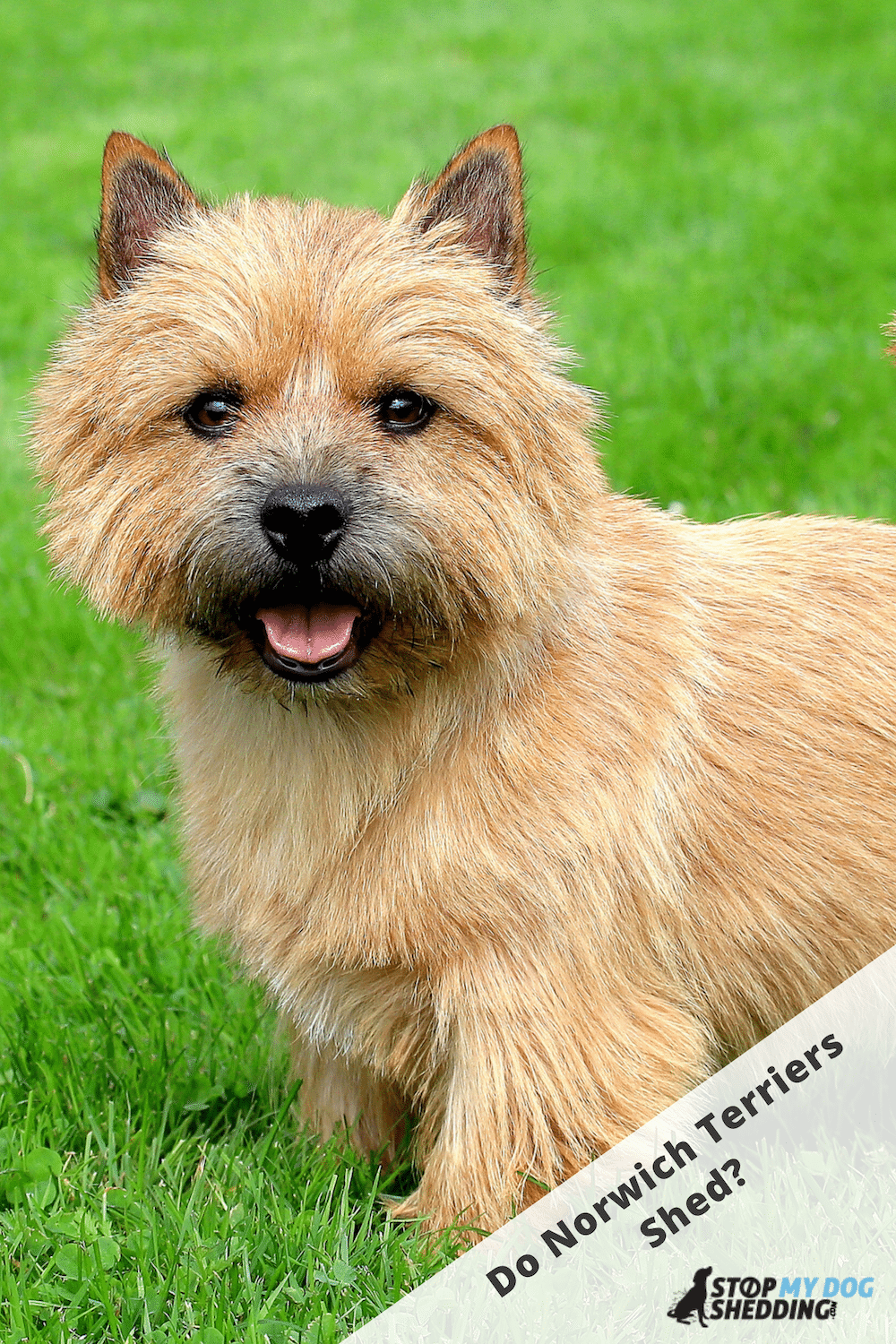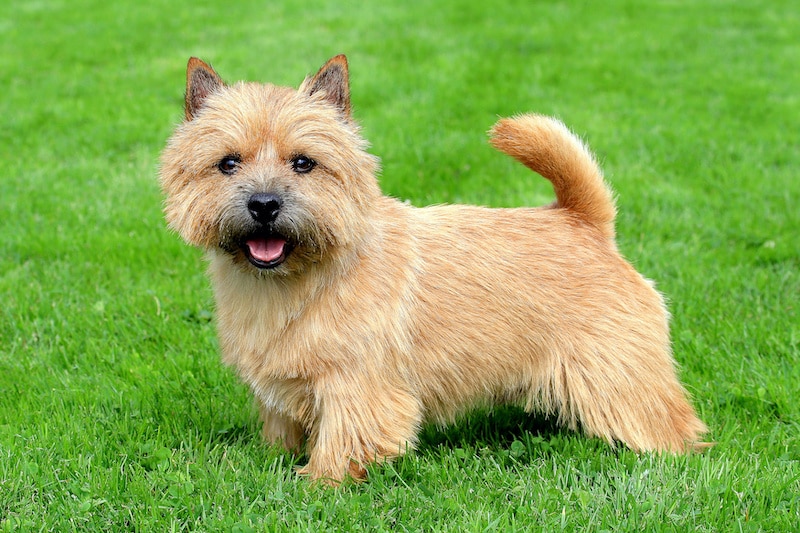Norwich Terriers are small dogs that were originally bred to hunt rats, which is something they share in common with breeds like the West Highland White Terrier. As time went on, however, these energetic, affectionate dogs became prized companions the world over.
Do they shed much? No, Norwiches are not heavy shedders by any stretch, they actually molt very little hair year-round. But given their wiry double coat, they can be a bit high maintenance when it comes to grooming.
In this article, we’ll take a closer look at how much hair Norwiches shed in more detail, along with what they’re like to groom to help you decide if this is the right breed for you.
Shedding
Norwich Terriers are a low shedding breed.
They’re not completely “non-shedding” though, because unless you get a hairless breed, that breed simply doesn’t exist. And they’re not as low shedding as breeds like the Poodle either. But overall they are definitely low shedders.
It really depends on the breed and individual dog as to how much hair they molt, but there are a couple things that work in the Norwiches favor with respect to molting.
The first is that they have a longer hair growth cycle than many dogs, which basically means that it takes longer for their hair to grow, die and fall out. Some say this means they have “hair and not fur,” but that’s a whole different story. The second reason the shedding is minimal is that, when they do molt, the hair tends to get caught up in their coat, given its texture.
Norwiches are also generally considered to be more suitable for people with pet allergies due to their low-allergenic coat. Some would even say they are “hypoallergenic.”
But there are a couple reasons to be cautious of this claim:
- Norwich Terriers are not listed as hypoallergenic on the American Kennel Club website. And the AKC is one of the most trusted sites in dogdom, so this is something I consider.
- Even dogs that are listed as hypoallergenic on the AKC website are not 100% hypoallergenic. Because most experts agree that pet allergies are not caused by the dog’s hair, but by their dander (dead skin). And since every dog produces dander, they can all cause allergies in some people. It’s just that some produce less dander and shed less, therefore spreading less dander around the home.
So, Norwiches may be more suitable for people with dog allergies compared with a heavy shedding dog that produces lots of dander. But at the same time, there are no guarantee he won’t cause problems for those with allergies either.
Also worth mentioning is that Norwiches do have an undercoat, which means you may notice an uptick in shedding during times like spring and fall as they adapt their coat to the changing season. So if you do notice heavier shedding once or twice a year, this could be why.
That said, sometimes shedding can be caused by other factors such as poor diet, fleas, allergies or skin conditions, among other things. So if you are concerned, contact your vet.
Grooming
Norwich Terriers are a double-coated breed, meaning they have an outer coat of hair as well as an undercoat of fur. The outer coat is made up of hard, wiry, straight hairs that come in black and tan, grizzle, red or wheaten. And the undercoat is soft and dense.
Together, this coat is virtually weatherproof and helps keep him insulated from both hot and cold weather alike.
Overall, his coat does require more attention than the average dog. But just how difficult and time consuming a Norwich is to groom really depends on how you keep his coat.
There are basically three main options of how to keep his coat – stripping, trimming and letting it grow wild – and each comes with a different set of pros and cons.
- Hand stripping: This is the most time consuming method of all. It basically involves stripping (or plucking) the old, dead hairs off of his coat by hand or with a stripping knife, twice per year. This is typically only performed on show dogs, but it’s the best way to keep the rich color and unique texture of his coat intact, so some prefer it.
- Trimming: What most people do is have their Norwich trimmed by hand or with clippers as it is simpler and less expensive to have someone do this. It also makes the hair shorter and therefore easier to brush. However, his coat won’t retain its beautiful color and texture as much as if you hand stripped it.
- Let it grow: The final option is to simply leave the coat as is, and grow wild, with maybe the occasional trim to keep it from growing totally out of control in some areas, like around the face. The plus side to this is that it’s easy. The downside is that brushing will be more of a chore and he will typically shed more than if you stripped him.
Which grooming method you choose is entirely up to you. As you can see, each has their own advantages and disadvantages. But if you’re sole concern is shedding, either hand stripping or trimming is best.
Just keep in mind that hand stripping is not easy to do and unless your dog is accustomed to it, he may not like it. Because you’re literally plucking hairs off of his body! Not to mention, not many groomers even know how to do this, so it’s not the cheapest option either. And this is why most people simply have him trimmed several times a year. It’s easier, more practical and less costly.
There’s also a kind of “cheat” method that some people use though, that basically involves using an undercoat rake. So if you want the hand stripped look, without the hand stripped effort or cost, this may be for you.
Here’s a video that shows you how it’s done:
In any case, regardless of which method you choose, you will still need to brush him on a regular basis (once or twice per week) to keep his wiry coat from becoming matted and tangled. And a metal comb or slicker brush is ideal for general coat maintenance and removing any loose hairs.
Aside from brushing and trimming, it’s fairly easy to look after a Norwich. The occasional bath, nail trimming and ear cleaning are things to consider, as with any dog.
Bottom Line
Norwiches are a small dog with a mighty spirit, and they don’t shed very much either. So if you’re looking for a low shedding companion, he’s up there with the best of ’em.
That said, like the Scottish Terrier and Norfolk Terrier, his wiry coat does take more time and effort to maintain than a dog with a short coat. It does depend on how you keep it, but there are some other great low shedding, lower maintenance terriers out there.
Either way, I hope you found this article helpful!













Please note: By submitting a comment using the above comment form, you confirm that you agree with the storage and handling of your data by this site as detailed in our Privacy Policy.